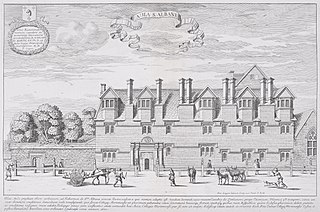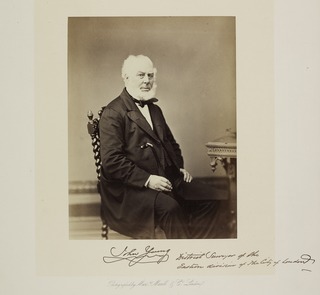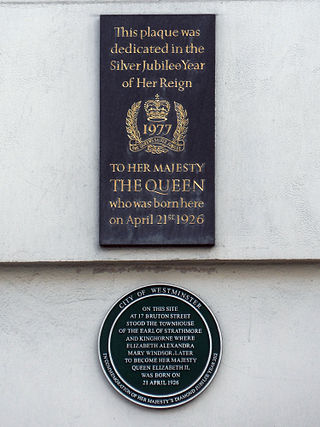Related Research Articles

Mayfair is an area of London, England, in the City of Westminster. It is in Central London and part of the West End. It is between Oxford Street, Regent Street, Piccadilly and Park Lane and one of the most expensive districts in the world.

The Metropolitan Borough of Westminster was a metropolitan borough in the County of London, England, from 1900 to 1965.

Hanover Square is a green square in Mayfair, Westminster, south west of Oxford Circus where Oxford Street meets Regent Street. Six streets converge on the square which include Harewood Place with links to Oxford Street, Princes Street, Hanover Street, Saint George Street, Brook Street and Tenderden Street, linking to Bond Street and Oxford Street.

James Piers St Aubyn, often referred to as J P St Aubyn, was an English architect of the Victorian era, known for his church architecture and confident restorations.

St Alban Hall, sometimes known as St Alban's Hall or Stubbins, was one of the medieval halls of the University of Oxford, and one of the longest-surviving. It was established in the 13th century, acquired by neighbouring Merton College in the 16th century but operated separately until the institutions merged in the late 19th century. The site in Merton Street, Oxford, is now occupied by Merton's Edwardian St Alban's Quad.

The Choir of St George's Chapel at Windsor Castle exists to sing services in St George's Chapel at Windsor Castle.

St Peter, Vere Street, known until 1832 as the Oxford Chapel after its founder Edward Harley, 2nd Earl of Oxford and Earl Mortimer, is a former Anglican church off Oxford Street, London. It has sometimes been referred to as the Marybone Chapel or Marylebone Chapel.

The Church of St Andrew, Holborn, is a Church of England church on the northwestern edge of the City of London, on Holborn within the Ward of Farringdon Without.

The Church of the Holy and Undivided Trinity with Saint Jude, Upper Chelsea, commonly called Holy Trinity Sloane Street or Holy Trinity Sloane Square, is a Church of England parish church in London, England. It was built in 1888–90 at the south-eastern side of Sloane Street, to a striking Arts and Crafts design, by the architect John Dando Sedding, and paid for by 5th Earl Cadogan, in whose London estate it lay. It replaced an earlier building only half its size which, at the time of its demolition, was less than 60 years old.
Trinity Chapel is a chapel within Canterbury Cathedral.

A proprietary chapel is a chapel that originally belonged to a private person, but with the intention that it would be open to the public, rather than restricted to members of a family or household, or members of an institution. Generally, however, some of the seating—sometimes a substantial proportion—would be reserved for subscribers.

Grosvenor Chapel is an Anglican church in what is now the City of Westminster, in England, built in the 1730s. It inspired many churches in New England. It is situated on South Audley Street in Mayfair.

Conduit Street is a street in Mayfair, London. It connects Bond Street to Regent Street.

John Young was an English architect and surveyor whose career spanned the grace of the Regency period and the pragmatism of the Industrial Revolution. While based primarily in the City of London, his practice, John Young & Son, Architects, was both eclectic and wide-ranging in South East England. He is particularly noted for his creative use of polychromatic brickwork whether in industrial, civic or residential contexts.

South Audley Street is a major shopping street in Mayfair, London. It runs north to south from the southwest corner of Grosvenor Square to Curzon Street.

Holy Trinity Church, also known as the Church of the Holy Trinity, is a Church of England parish church in the town of Reading in the English county of Berkshire. It is situated on the Oxford Road some 500 metres (1,600 ft) west of the town centre. It is a Grade II listed building.

Bruton Street is a street in London's Mayfair district. Queen Elizabeth II was born there, and the fashion designer Norman Hartnell lived there for 44 years.

Hanover Chapel was a church in Regent Street, London. It was built in 1825, and was demolished in 1896.
St Thomas's Church, also known as Tenison Chapel, was an Anglican church in Regent Street, London. It was built in 1702, on the site of a wooden chapel of 1688; it was a proprietary chapel until 1869, when it became a district church dedicated to St Thomas. It closed in 1954, and was later demolished.
References
- 1 2 3 4 Edward Walford. 'Hanover Square and neighbourhood', in Old and New London: Volume 4 (London, 1878), pp. 314-326 British History Online. Retrieved 25 March 2023.
- 1 2 3 "St George’s Hanover Square – and Its Remarkable Neighbour, Trinity Chapel" Jane Austen's London. Retrieved 26 March 2023.
- ↑ Tedder, Henry Richard (1897). . In Lee, Sidney (ed.). Dictionary of National Biography . Vol. 49. London: Smith, Elder & Co. pp. 61–62.
- ↑ "Location: Parochial Chapel: Trinity Chapel, Conduit Street" theclergydatabase.org.uk. Retrieved 26 March 2023.